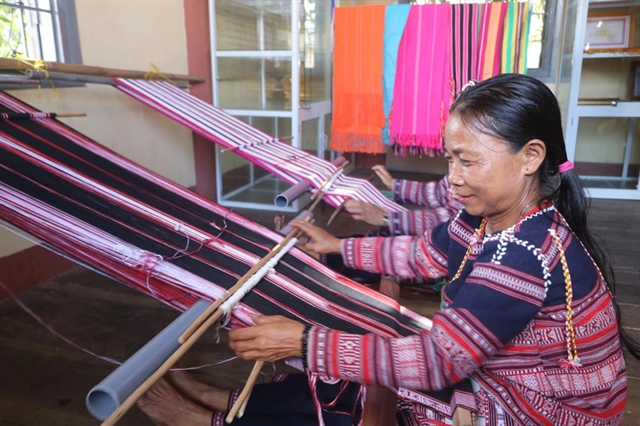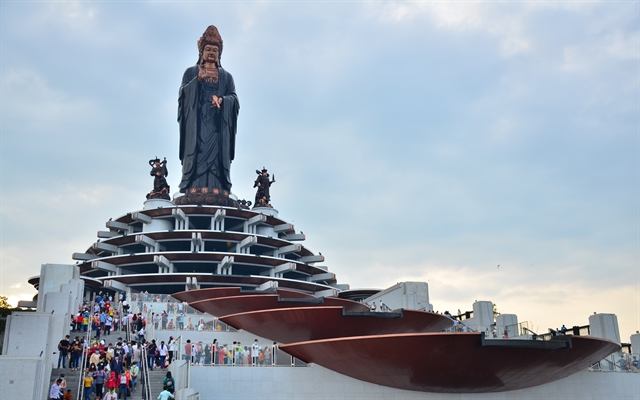 Life & Style
Life & Style

 |
Bà Đen Mountain is one of the most popular destinations in Tây Ninh Province. Photo courtesy of baotayninh.vn
HCM CITY - The southern province of Tây Ninh aims to make tourism a key economic sector by 2030, contributing over 10 per cent of Gross Regional Domestic Product (GRDP).
Tây Ninh’s tourism industry in the period of between 2016 and 2020 made important contributions to the locality's socio-economic development, creating thousands of jobs and raised a better quality of life in both rural and urban areas.
As tourism is considered one of the pillars for the province's socio-economic development, multiple solutions, with a focus on Bà Đen Mountain, have been implemented.
The province invited a number of strategic investors, including Vingroup and Sungroup, to participate into development of a number of large projects, such as construction of a commercial center complex, shophouses, a five-star Vincom plaza hotel and a cable car system to the top of Bà Đen Mountain.
During the period, provincial tourism revenue reached VNĐ4.32 trillion (nearly US$18.8 billion), up nearly 50 per cent compared to 2011 and 2015.
However, despite how close Tây Ninh and neighbouring Cambodia are, the province has yet to attract many international tourists.
Challenges and plans
To be sure, some challenges need to be overcome, especially competition in the tourism market with neighbouring provinces, extended travel time between Tây Ninh and HCM City, a lack of attractive destinations for tourists to visit and stay at, limited nightlife entertainment and uncoordinated infrastructures, among others.
Recently, the provincial People's Committee drafted a tourism development plan for 2025 to 2030, which emphasises effective use of available resources, establishment of a unique tourism brand and an upgrade of Bà Đen Mountain National Tourism Area into one of the high-class tourism areas of the region and Việt Nam.
Relevant authorities are required to strengthen coordination, promote Tây Ninh’s tourism in a systematic manner to maximise its potential in cultural and spiritual tourism, and provide travel agencies with favourable policies to efficiently boost the sector.
Tây Ninh will enhance the value chain, increase the proportion of tourism in its GRDP, promote socio-economic development, make tourism a spearhead for the economic sector of the locality, and promote heritage values and national cultural identity, among others.
Advanced 4.0 technology will be applied in tourism promotion to step by step develop a smart tourism system and improve the competitiveness of the province.
It is also crucial for tourism facilities to scale up, be capable of hosting large numbers of tourists during festivals, train quality human resources available for language translation at popular attractions and create more meaningful and diversified tourism products.
From now until 2025, authorities expect tourism to generate about 7,400 tourism jobs, including 2,600 direct jobs and 4,800 indirect jobs.
Tourism revenue between 2021 and 2025 is expected to reach VNĐ9 trillion ($391.3 million), while tourist visitors will reach 18 million arrivals.
The growth rate of tourism revenue has increased by an average of 25 per year or more per year while the average expenditure of tourists in Tây Ninh has reached over VNĐ1.3 million per person per day.
Tourism revenue in 2026-30 is expected to reach VNĐ35 trillion, revenue from travel services to reach VNĐ235 billion and tourist visitors in 2026-30 to reach 37 million arrivals.
Traffic infrastructure
The Tây Ninh People's Committee realises the importance of simplified and transparent administrative procedures related to investment and business registration to efficiently develop the tourism sector.
It is fundamental to support business innovation, improve the business environment and strengthen post-inspection work on investment projects that are slow to be implemented or ones that are not effective.
With regards to infrastructure development, Tây Ninh will connect to neighbouring provinces via key projects, such as the HCM City - Mộc Bài Expressway, HCM City Road (the Chơn Thành - Đức Hoà section, the connecting road from Tây Ninh to Bình Dương and An Hoà Bridge, among others.
Traffic projects on the main traffic axes of the province, including Trường Chinh Street, and extending Hoàng Lê Kha Street, Nguyễn Chí Thanh Street and Nguyễn Trọng Cát Street, will be carried out.
Tây Ninh will also coordinate with the HCM City transport authority to study the potential of high-quality bus routes from the province to the inner districts of HCM City. - VNS




